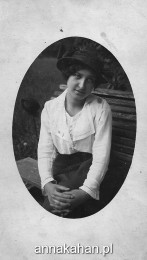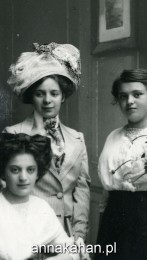[The Millinery]
In her Diary, Anna writes a lot about her work, which she undertook at the age of ten. It is presumed that she worked at 24 Warszawska Street in the millinery shop of Ajzensztadt who also owned a colonial shop. Anna recalls that the building had a balcony, which means that it was a storey house.
The working conditions were extremely harsh.
“It is true. The room we work in has no air or sun. The iron bars on the windows, the dank walls, the musty odor, remind me of a prison. Oh, how I’d love to get away from here!”
She wrote it at the age of fourteen with four years of work behind her. She earned 4 rubles per month. Soon, she was the only employee in the history of the shop whose salary was doubled. However, considering that a pair of shoes cost 3 rubles, her 8 rubles salary was not impressive.
Let us recall what Anna’s work was. It may not be so obvious now. She made wireframes for hats, sewed hats and muffs, took orders from the customers, and in June 1915, she sewed gas masks for the Red Cross. According to her employer, she was supposed to work for 12 hours a day, from 9.00 a.m. to 9.00 p.m. Yet she often worked to 10.00 p.m. and sometimes due to a large volume of orders, she went home around 11.00 p.m. This situation happened quite often before holidays. The frequency of holidays during the partitions was associated with the fact that in Siedlce lived followers of the three religions: Orthodoxy, Christianity, and Judaism. The German occupiers, a fourth group, joined later on.
After returning home from work, she often did not have the strength to write her Diary. It was also connected with her household duties. In the morning, she had to buy bread for her family and bring water. In the prevalent conditions, with frozen pumps on the street, and waiting in queues, it was quite burdensome. Besides, after work she sewed hats for her family.
The designs of headgear were imported from Warsaw and copied. Anna liked some of them and considered them very pretty. Others seemed to her strange, but she described them as unique. She worked together with Itka, Mindla, Zina, and Estusia who was two years younger than her, and briefly with the designer Merada.
There were days when no one placed orders for new products. Then the girls browsed through the boxes with accessories and dusted them. In addition, they checked the condition of unsold hats and prepared them for modification in the next season. Anna worked on holidays including the Jewish ones. The attitude of her employer outraged her friends. The nature of her work, time load, and her mood are reflected in the following quotation from January 7, 1915, which was the day of Orthodox Christmas holiday.
“(…) all stores are closed, but our little shop is open. However, we were told to come in later in the morning and we’ll leave earlier, too. (…) The streets look festive with the flags waving from windows and gates (…) and the promenading people. Many sleighs are gliding over the snow and the bells make a tingling, musical sound.
However, no holiday inside the store. We sit and sew. I cover a frame with black velvet. I pull it very tight over the buckram and slip-stitch it so that the thread doesn’t show. It’s an expensive hat, it’ll be trimmed with ostrich feathers. They now give me expensive hats to work on. I must be good.”
The shop was situated between two buildings in which were located quite important trading points. Previously, at number 22 was the pharmacy, while from the western side, at number 26 was a stationery shop of H. Celnik. It is worth mentioning that during the First World War, the owner of this shop also published postcards with views of Siedlce.
Going forward we reach the place of a former synagogue. Now, there is an obelisk commemorating the extermination of the Jews of Siedlce.



